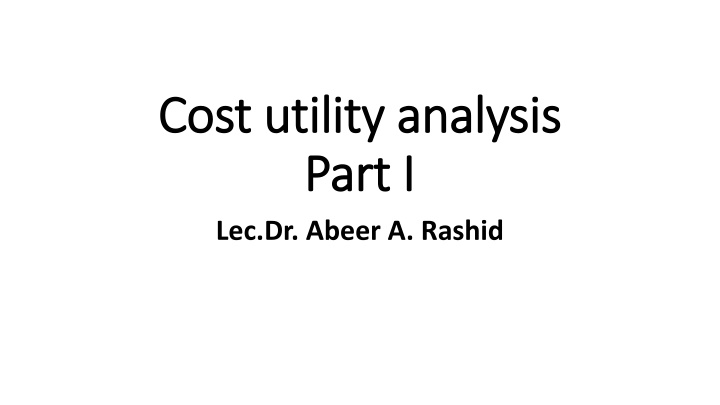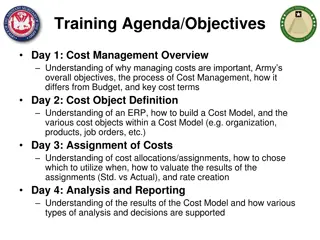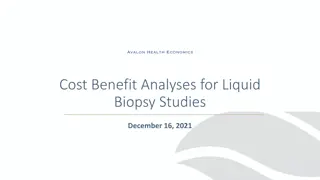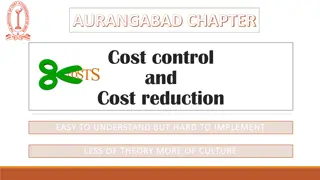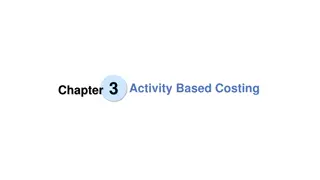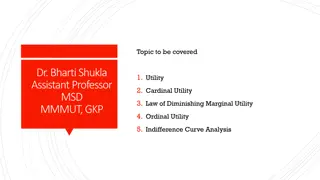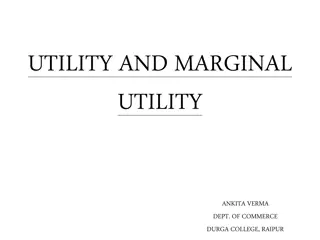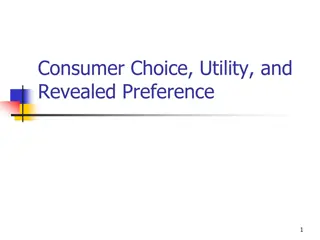Cost utility analysis
Cost-utility analysis (CUA) in healthcare involves measuring patient preference for interventions based on well-being, using quality-adjusted life-years (QALYs) as a common unit. It allows comparison of different health outcomes and diseases. However, accurate utility determination and understanding of estimating utilities/QALYs can be challenging. CUA is appropriate when health-related quality of life is a crucial outcome and when interventions affect both morbidity and mortality.
Download Presentation

Please find below an Image/Link to download the presentation.
The content on the website is provided AS IS for your information and personal use only. It may not be sold, licensed, or shared on other websites without obtaining consent from the author.If you encounter any issues during the download, it is possible that the publisher has removed the file from their server.
You are allowed to download the files provided on this website for personal or commercial use, subject to the condition that they are used lawfully. All files are the property of their respective owners.
The content on the website is provided AS IS for your information and personal use only. It may not be sold, licensed, or shared on other websites without obtaining consent from the author.
E N D
Presentation Transcript
Cost utility analysis Cost utility analysis Part I Part I Lec.Dr. Abeer A. Rashid
Cost utility analysis Cost utility analysis Utility is the measurement of patient preference for a particular intervention in term of patient well being. The most commonly used outcome measure in this type of analysis: quality-adjusted life-years (QALYs) gained. A QALY combines survival periods (quantity of life) with health status valuations (quality of life) to provide a standard unit for measuring health gain. Utility is an index which ranges in range between 0 (representing death) and 1 (representing perfect health)
The advantage of a CUA 1. different types of health outcomes and diseases with multiple outcomes of interest can be compared (unlike in CEA). 2. using one common unit such as the QALY. 3.CUA incorporates morbidity and mortality into this one common unit without having to determine or estimate the monetary value of these health outcomes (unlike CBA).
The disadvantage of CUA 1.It is difficult to determine an accurate utility or preference weight value 2. the methods for estimating utilities/QALYs may not be fully understood by many providers or decision makers.
When Is Cost-Utility Analysis Appropriate? 1.When health-related quality of life is the important outcome 2. When health-related quality of life is an important out- come 3. When the intervention affects both morbidity and mortality and a combined unit of outcome is desired 4. When the interventions being compared have a wide range of potential outcomes and there is a need to have a common unit of outcome for comparison. 5. When the objective is to compare an intervention with others that have already been evaluated in terms of cost per QALY (or equivalent) gained.
Steps in Calculating QAlYS: 1.Develop a description of each disease state or condition of interest. 2. Choose a method for determining utilities. 3. Choose subjects who will determine utilities. 4. Sum the product of utility scores by the length of life for each option to obtain QALYs.
step 1: Develop a description of each disease state or condition of interest. The description should concisely depict the usual health effects expected from the disease state or condition. It should include the amount of pain or discomfort, any restrictions on activities, the time it may take for treatment, possible changes in health perceptions (worry or concern), and any mental changes.
Example Example Description of Hospital-Based Kidney Dialysis You often feel tired and sluggish. A piece of tubing has been inserted into your arm or leg, which may restrict your movement. There is no severe pain but rather chronic discomfort. You must go to the hospital twice a week for 6 hours per visit. You must follow a strict diet (low salt, little meat, no alcohol). Many people be- come depressed because of the nuisances and restrictions, and some feel they are being kept alive by a machine.
Step 2: Choose Method for Determining utilities 1. direct elicitation (rating scale, standard gamble, and time tradeoff) 2. Indirect elicitation methods, using standardized weightings (e.g., EQ-5D and SF-6D surveys)
B.Standard gamble B.Standard gamble example, a person considers two options: a kidney transplant with a 20% probability of dying (80% chance of returning to normal health) during the operation (Alternative 1) or certain dialysis for the rest of his or her life (Alternative 2). If the person says he or she would have the operation if the chance of the successful operation p is 80% (chance of immediate death, 20%), the percent chance of success is decreased until the person reaches his or her point of indifference (the point where the two options are nearly equal and the person cannot decide between the two). If the person says he or she would not have the operation if the percent chance for success was 80% (chance of dying, 20%), the percent chance of success is increased until the person reaches his or her point of indifference
C.Time tradeoff C.Time tradeoff Alternative 1 is a certain disease state for a specific length of time (t), the life expectancy for a person with the disease, and then death. Alternative 2 is being healthy for time x, which is less than t. Time x is varied until the respondent is indifferent between the two alternatives. The utility score for the health state is calculated as x divided by t.
For example, a person with a life expectancy of 40 years is given two options Alternative 1 is having a chronic condition (e.g., kidney disease or diabetes) for 40 years, Alternative 2 is being healthy (no disease) for 20 years followed by death. If the person says he or she would rather have the disease for 40 years (t) than be healthy for 20 years, the number of years (x) in the healthy state is increased until the person is indifferent between the two alternatives. If the person would rather be healthy for 20 years than have the disease for 40 years, the number of years (x) in the healthy state is decreased until the person is indifferent between the two alternatives. Let us say that for a person who expects to live 40 more years, the person s point of indifference is 30 years of health versus 40 years of kidney disease. The utility score would be x/ t = 30 / 40 or 0.75.
Comparisons of the Three Methods The advantage of using the RS method to determine utilities is that 1. many disease states or conditions can be described to each subject 2. can be conducted via a questionnaire without face-to-face interaction. 3. it is less cognitively demanding than the other two methods. The disadvantage of using the RS method is that: 1.it does not incorporate time into the utility score as easily as the other two methods. 2.It also may be biased in that people do not tend to cluster their values at the extreme ends of the scale.
The advantage of using the SG method is that 1.it is the gold standard and based on economic theory. The Disadvantages of SG 1. people have difficulty understanding probabilities 2.subjects need to answer repeated questions, influenced by how the questions are phrased or presented. 3. It is time consuming 4. this is better administered in a face-to-face setting, or through an iterative process, which takes more resources than a self-administered questionnaire. 5. treatment of most chronic diseases does not approximate the gamble.
The advantages of the TTO method are that 1.it is more adaptable to diseases states than the SG, and it incorporates the time in the disease state or condition more easily than the RS. The Disadvantages of TTO 1. It is time consuming ,subjects need to answer repeated questions because the time in a healthy state varies depending on the subject s previous answers 2.require face-to-face administration or an iterative process
2. Indirect elicitation method: Generic measures:are more useful when looking at groups of patients who may have different illnesses, and can be used to compare outcomes in different patient groups. One of the most widely used is the Short Form (SF)- 36 health survey. This looks at: Physical functioning Physical role Bodily pain General health Vitality Social functioning Emotional role Mental health.
Euroqol (EQ-5D) EQ-5D has five dimensions: mobility, self-care, usual activities, pain/ discomfort and anxiety/depression. There are three levels per dimension and respondents/patients describe themselves within this system.
